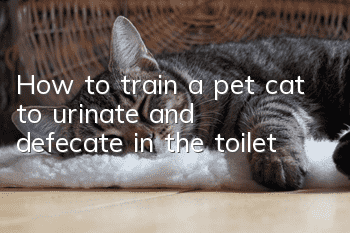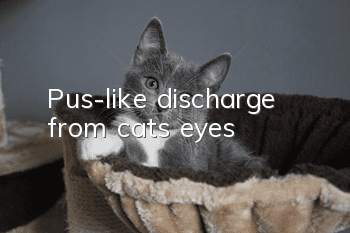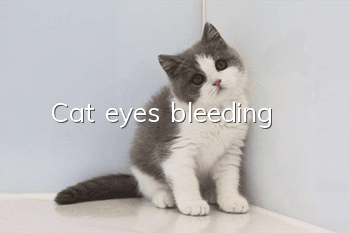How to train a pet cat to urinate and defecate in the toilet

Cats are very cute. Having a little guy to play with when you come home after a busy day will make you feel better. However, many families who raise cats find it very troublesome to deal with cat excrement every day, making people think that raising cats is too troublesome. Some cats will also behave wherever they want, which makes their owners very embarrassed. But in fact, this is mainly due to their poorly trained owners! Why do you say this? Take a look at these 4 points, are you doing the same?
How to train a cat to urinate and defecate in the toilet. 4 tips to keep the cat away from random excretion. 1. Psychological factors of cats excreting randomly
1. Cats’ psychological stress and habits
Cats are very sensitive and stubborn animals. Just the slightest disturbance will cause them psychological stress; and their habits are difficult to change according to the owner's requirements! When they relieve themselves somewhere at home, they feel comfortable. and safe, it will often excrete there. If the owner interferes with it, it will find other suitable places at home to urinate and constantly change places.
2. Arrival of new members
When there are new members in the family, such as new cats or puppies or other pets bought by the owner, or even when the hostess gives birth to a child, some cats will become nervous and uneasy, and some cats may even become jealous. . For this reason, cats will excrete randomly to express their dissatisfaction with their owners and other animals.
3. Protest against the owner
(1) Cats are naturally animals that like to be pampered by their owners. If the owner neglects to take care of the cat due to busy work or other things, the cats will protest your negligence by urinating everywhere.
(2) Some cats like to go to the toilet in hidden places or use covered toilets. Sudden changes in your cat's habits, or changing their favorite litter box, infringing on their privacy, can also cause your cat to resent you and retaliate against you by urinating everywhere.
How to train a cat to urinate and defecate in the toilet. 4 tips to keep cats away from random excretion. 2. Physiological factors and environmental factors of cats’ random excretion
1. Physiological factors
(1) Estrus: During the period of estrus, uncastrated male cats will spray urine randomly to divide the scope of their rights; similarly, female cats in estrus will also urinate and defecate randomly;
(2) Pregnancy: Pregnant female cats may also urinate and defecate everywhere due to physical discomfort;
(3) Disease: Some cats suffering from urinary system diseases. Due to the pain affecting defecation, the phenomenon of urinating and defecating will also occur.
2. Environmental aspects
(1) New home: The family has moved to a new home and the home environment has changed, causing the cat to be at a loss when defecating
(2) Too dirty environment: Too dirty and messy environment at home is also a problem. Cats are pets that like to be clean. If the litter box is too dirty, the cat litter is not changed in time, and the environment is too dirty, it will also cause the cat to think where to excrete. It all feels the same.
How to train a cat to urinate and defecate in the toilet. 4 tips to keep the cat away from random excretion. 3. Train the cat to follow the discipline of going to the toilet
1. Well-trained training
No matter how cute a cat is, if it poops and poops on the sofa and clothes casually, its cuteness will be greatly reduced. This is a big misfortune for cats. If your cat is well trained to go to the toilet, your home will be cleaner. Originally, cats like to be clean and are pets that are easy to train to go to the toilet. Although some cats may also do it wherever they want, making it difficult for their owners, this is mainly due to owners who fail to train well.
2. Take the cat to the toilet repeatedly
(1) Early training when moving to a new home: From the first day the cat steps into someone’s door, it should be trained to use the toilet. Training as early as possible is more effective. Set up cat toilets in corridor corners, balconies and other places where cats can freely enter and exit. Cats who are not accustomed to their new home will become restless when they feel the urge to defecate. This is a good time to train them to go to the toilet.
(2) Use cat litter: Carry the cat into the prepared toilet. At first, it may crawl out at a loss. This is not uncommon, but you have to say to it softly: "The toilet is here." Then repeat it a few times and put the sand and paper towels stained with cat feces into the toilet. The cat can feel at ease when it smells its own scent. When the cat has finished relieving himself successfully, don't forget to praise him for "well done". As long as the training is repeated in this way, it will be very effective. Some cats will even come back to use the toilet when they are outside.
How to train a cat to urinate and defecate in the toilet. 4 tips to keep the cat away from random excretion. 4. Train the cat to use the toilet
1. Train cats to use the toilet
It is very easy to train a cat to use the toilet. Cats love to be clean and defecate in fixed places. It is very easy to train a cat to use the toilet. If the toilet at home is a squat toilet, you only need to remove the cat litter box and tie the cat to the squat toilet. The cat can be taught to excrete in the squat toilet in two or three days. Kittens that have just arrived at home at 3 or 4 months old only need to Pay attention to its excretion behavior and you can teach it almost immediately.
2. Train cats to use the flush toilet
Material preparation: plastic board (or wooden board instead); sand, furnace ash or sawdust and other bedding materials;
Steps:
(1) Place a plastic plate (or replace it with a wooden board) under the toilet seat.
(2) Spread an appropriate amount of sand, furnace ash or sawdust and other bedding materials on the plastic board or wooden board.
(3) When you find that your cat needs to defecate, take it to the toilet immediately. Soon, it will defecate on its own.
(4) After several times of patient training, the cat gradually formed the habit of defecating on the toilet with padding. After that, the padding on the plastic board or wooden board was gradually reduced. In the process, the cat quickly learned that it You should stand on the toilet seat to defecate and urinate, rather than standing on the low-level padding inside the toilet.
(5) Then gradually remove all the bedding material and drill a hole in the plastic board to facilitate the drainage of urine. If the bedding is removed too early and the cat no longer wants to defecate on the toilet seat, you will have to start training again. In short, wait until your cat gets into the habit of standing on the toilet seat to relieve himself before removing the plastic or wooden board.
How to train a cat to urinate and defecate in the toilet. 4 tips to keep the cat away from random excretion. During the training process, you should also pay attention to several details. First of all, replace the bedding that has been soiled by urine or feces every day, and always keep the toilet clean. Doing so can speed up the training process; secondly, during training, people are prohibited from using the toilet at the same time, especially when cats urinate and defecate on the toilet. Do not disturb or obstruct it; thirdly, some cats may accidentally slip and fall into the toilet. Such cats generally will not go to the toilet to relieve themselves. At this point, the owner has to start training from scratch until the cat learns to defecate in the toilet. Article source: Remigo Pet Official Account
- Things you must pay attention to when training cats, novices must know!
- How to develop social behavior in kittens?
- What are the requirements for shipping cats?
- What should I do if my cat has poor digestion? What should cats eat if they have poor digestion?
- Will Ragdoll cats grow larger than dogs?
- Is a cat’s IQ high? (A cat’s IQ is the age of a human’s IQ)
- Why are more and more people keeping native cats?
- What color are orange cat eyes?
- Seven foods that can help cats increase their appetite
- How often should cats be fed canned food?



